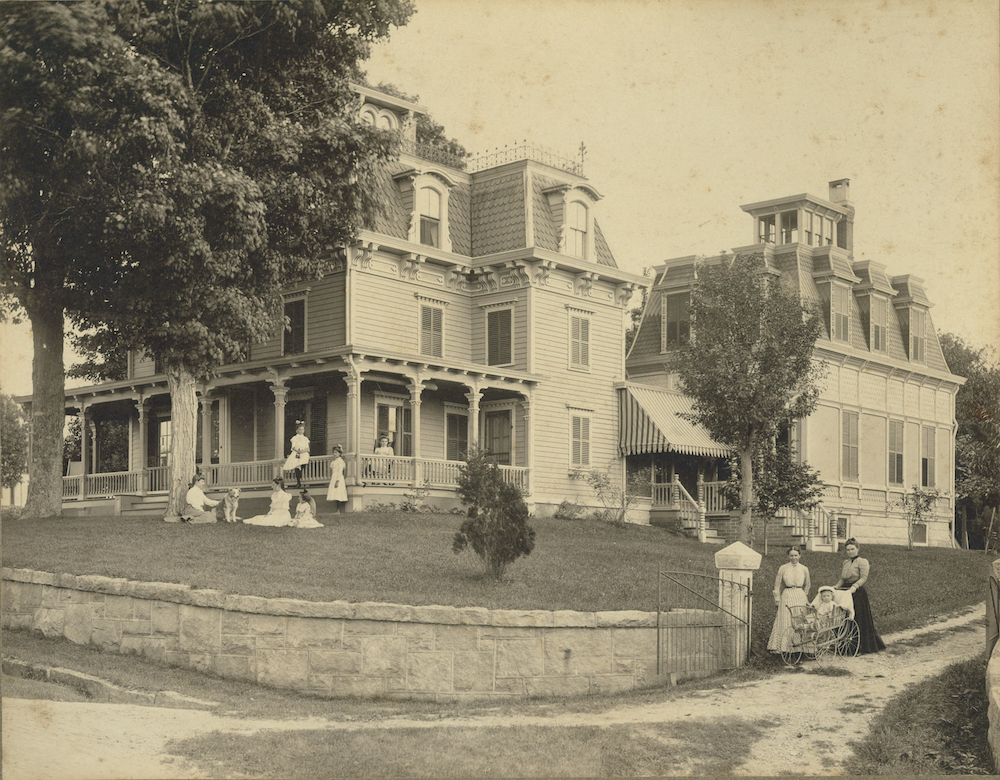Oenoke Ridge and Luke's Wood Road
The historical marker on the corner of Luke’s Wood Road and Oenoke Ridge is all that remains of Pinney’s Corner.
Pinney Corner, former home of Henry Augustus Pinney, was a bustling community in the 1880s. Pinney, originally from Milford Pennsylvania, had a brief residency in Pleasantville, New York before moving to New Canaan in 1868. In 1870 he started a small shoe factory situated on three acres of land across from his home on the corner of Lukes Wood Road and Oenoke Ridge Road. His home, where he lived with his wife, Adelia Hoyt and his two surviving daughters (having lost three others as infants) grew as his wealth increased. Despite having a relatively small family, Mr. Pinney built an addition to the house that was attached to the original building by a single hallway The leftmost structure in the picture above is the original building. Ms. Warren also remarked that her father was a fan of spirited horses and fine carriages. The shoe factory, where he manufactured fancy women’s shoes, began with twelve workers but rapidly grew to employ over fifty men. The shoe business was booming at the time, evident by the fact that New Canaan was the third largest manufacturer at the time and was producing 50,000 pairs a year! The production of shoes left little time to travel the three miles to town for supplies so Mr. Pinney opened a convenience grocery store near the factory for his employees.
All accounts of Mr. Henry Pinney described him as being a man of action and some recount that he had a “puckish” sense of humor. Mr. Pinney, having retired from the shoe business after running his company for thirty years, became a director at the First National Bank in New Canaan. The New Canaan Annual recounts a story of him posing as a sheriff escorting a notorious criminal on the train to New Haven when in reality his fellow traveler was his own bank book keeper, Andrew F. Jones. Pinney reportedly asked the fellow passengers to look after the criminal while he went to the front of the train. Needless to say, Mr. Jones did not find this as amusing as Pinney! Pinney was also a significant investor in the patent owned by the Perfection Co. that improved weighing scales in 1880, further advancing his fortune. His property on Pinney Road was assessed at $4220 in the 1907 accounting. Mr. Pinney died in November 1908 of heart and kidney issues. His wife, Adelia, continued to live at the family home until she sold it to A.H. Mulliken. Adelia Pinney lived for another 25 years and died just short of her 99th birthday, making her one of the oldest residents in town.
Alfred Henry Mulliken was the president of Pettibone Mulliken in Chicago, maker of railroad supplies. Mr. Mulliken tore down the Pinney house in 1925 and added it to his existing estate on West Road. The New Canaan Advertiser reported that the Mulliken property was the proud owner of the largest Elm tree in the state in 1912 (but it is unclear just where this historic tree was located).
Pinney Road, which was known as Pound Ridge Road for many years became part of Oenoke Ridge Road in 2002. The residents of Pinney Road petitioned the town to change the name because it was confusing to have the name change from Oenoke to Pinney at the corner. The town agreed to this change after the second petition but requested that the marker that currently stands be installed.
“New Canaan Now & Then” is presented in partnership with the New Canaan Museum & Historical Society.




My grandparents, Rose and George Kruger, bought property nearby on Lukes Wood Road in 1912 – a plae they called Elm Acres – with an 1894 farmhouse which remained in the family until we sold it in 2021. As children, my sister and I waited for the school bus at Pinney Carner, where the few children on Lukes Wood gathered. There was little traffic or crime, making the road safe for kids to walk which we did, happily fron the 1940s through the 1960s. .
The most dramatic incident I remember from th early 1950s was the morning a small food delivery van drove too fast heading into the curve, tipped over, and spilled produce all over the intersection. In no time, the housewives in the neighborhood heard the news, which inspired some of them to take large baskets or even a wheelvarrow to help themelve to the high quality vegetables, fruits, some unbroken eggs. That corner has always invited crashes by speeding drivers who don’t look ahead.
Looking at the Historical Society photograph above, it is hard to imagine what the corner would have looked like then. Particularly what look like sidewalks intersecting at a sharp angle. The shot looks as if it were in town – brt a the turn of the century perhaps that was indeed what Pinney Corner was.